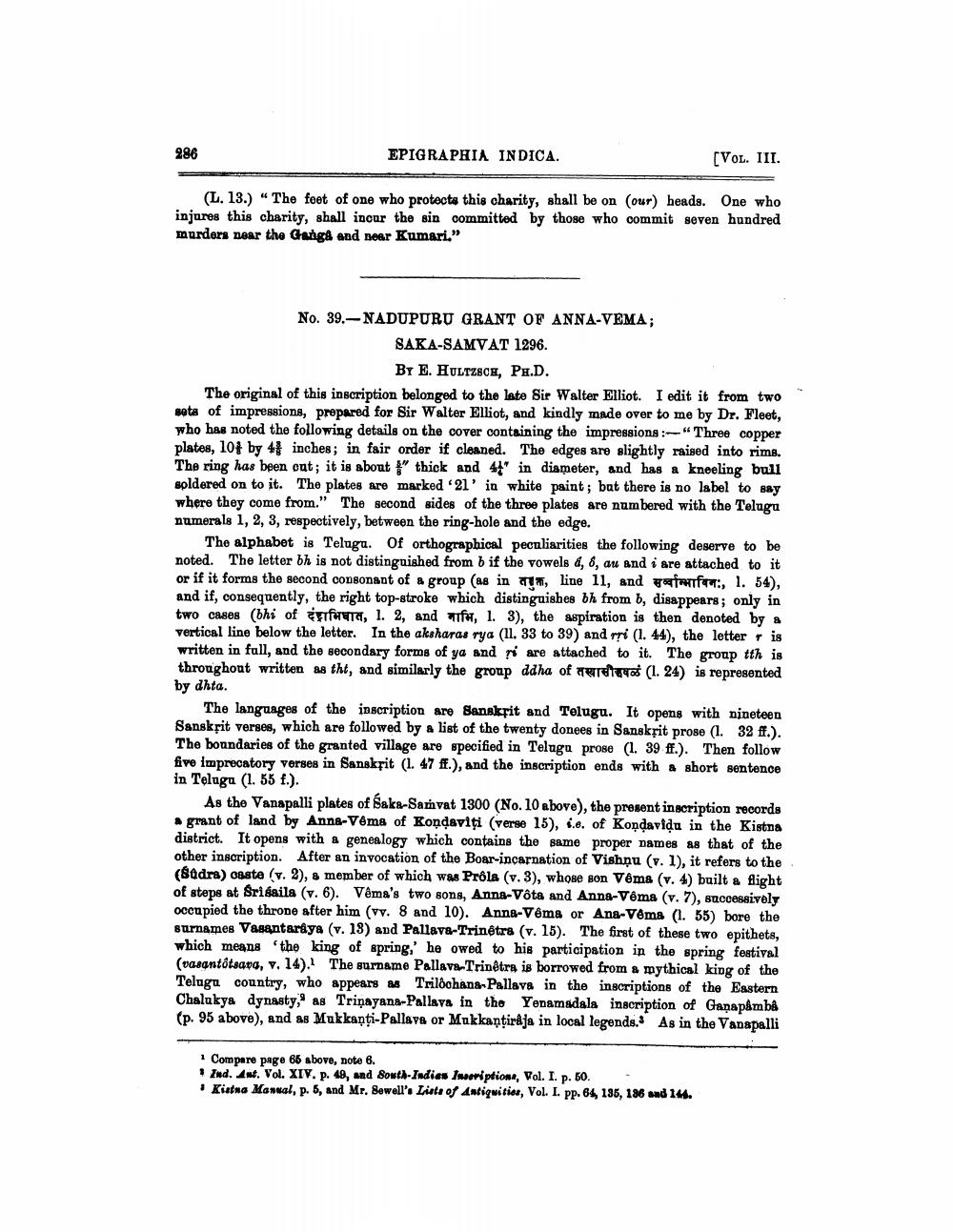________________
286
EPIGRAPHIA INDICA.
[VOL. III.
(L. 13.) " The feet of one who protects this charity, shall be on (our) heads. One who injures this charity, shall incur the sin committed by those who commit seven hundred murders near the Ganga and near Kumari.”
No. 39.- NADUPURU GRANT OF ANNA-VEMA;
SAKA-SAMVAT 1296.
BY E. HULTZSCH, PH.D. The original of this inscription belonged to the late Sir Walter Elliot. I edit it from two sota of impressions, prepared for Sir Walter Elliot, and kindly made over to me by Dr. Fleet, who has noted the following details on the cover containing the impressions :-"Three copper plates, 10+ by 4 inches; in fair order if cleaned. The edges are slightly raised into rims. The ring has been out; it is about #" thick and 41" in diameter, and has a kneeling bull soldered on to it. The plates are marked 21' in white paint; bat there is no label to say where they come from." The second sides of the three plates are numbered with the Telugu numerals 1, 2, 3, respectively, between the ring-hole and the edge.
The alphabet is Telugu. Of orthographical pecnliarities the following deserve to be noted. The letter bh is not distinguished from b if the vowels 4, 8, au and i are attached to it or if it forms the second consonant of a group (as in 1, line 11, and a f t, 1. 54), and if, consequently, the right top-stroke which distinguishes bh from b, disappears; only in two cases (bhi of HTC, l. 2, and ifu, 1. 3), the aspiration is then denoted by a vertical line below the letter. In the aksharas rya (11. 33 to 39) and rri (1. 44), the letter is written in full, and the secondary forms of ya and rare attached to it. The group tth is
throughout written as tht, and similarly the group ddha of teretaro (1. 24) is represented by dhta.
The languages of the inscription are Sanskrit and Telugu. It opens with nineteen Sanskrit verses, which are followed by a list of the twenty donees in Sanskrit prose (1. 32 ff.). The boundaries of the granted village are specified in Telugu prose (1. 39 ff.). Then follow five imprecatory verses in Sanskrit (1. 47 ff.), and the inscription ends with a short sentence in Telugu (1. 55 f.).
As the Vanapalli plates of Saka-Saṁvat 1300 (No. 10 above), the present inscription records * grant of land by Anna-Vêma of Kondaviti (verse 15), s.c. of Kondavidu in the Kistna district. It opens with a genealogy which contains the same proper names as that of the other inscription. After an invocation of the Boar-incarnation of Vishnu (v. 1), it refers to the (Odra) oaste (v. ), a member of which was Prôla (v. 3), whose son Vêms (v. 4) built a flight of steps at Srisaila (v. 6). Vêma's two sons, Anna-Võta and Anna-Véma (v.7), successively occupied the throne after him (vv. 8 and 10). Anna-Vêms or Ana-Véma (1. 55) bore the surnames Vasantariya (v. 13) and Pallava-Trinetra (v. 15). The first of these two epithets, which means the king of spring,' he owed to his participation in the spring festival (vasantotsava, v. 14). The surname Pallava Trinetra is borrowed from a mythical king of the Teluga country, who appears as Trilhana-Pallava in the inscriptions of the Eastern Chalukya dynasty," as Triņayana-Pallava in the Yenamsdela inscription of Ganapamba (p. 95 above), and as Mukkanti-Pallava or Mukkaņtiraja in local legends. As in the Vanapalli
Compare page 66 above, note 6.
Ind. Ant. Vol. XIV. p. 49, and South Indias Inseription, Vol. I. p. 50.• Kitna Manual, p. 6, and Mr. Bowell's List of Antiquities, Vol. I. pp. 64, 185, 186 and 14.




